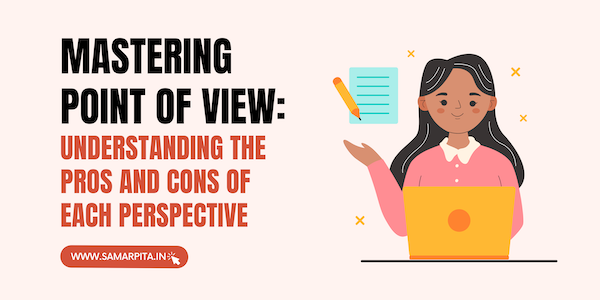Choosing the right point of view can make all the difference in how your story is perceived by your readers. But with so many different perspectives to choose from, it can be difficult to know which one is right for your story. In this blog post, we will explore the pros and cons of each point of view to help you make an informed decision.
Also Read: Getting Published: Tips and Tricks for Landing Your First Book Deal
First-Person POV
In the first-person POV, the story is told from the perspective of one character who is also the narrator. This POV is great for creating an intimate connection between the reader and the protagonist. It can also provide a unique insight into the narrator’s thoughts and emotions. However, it can be limiting in terms of what the reader can know and see beyond the narrator’s experience. It can also become tedious if the narrator is not likable or relatable.
Second-Person POV
The second-person POV is used less frequently, but it’s still an option for some writers. This POV is when the narrator speaks directly to the reader using “you.” It’s often used in instructional or self-help writing. It can be a powerful tool for creating a sense of intimacy between the reader and the narrator. However, it can be challenging to maintain this POV for an entire story without it becoming gimmicky or distancing the reader from the characters.
Also Read: Freelance Editing: How to Get Started
Third-Person POV
The third-person POV is the most common POV used in fiction. It’s told by an external narrator who is not a character in the story. There are two types of third-person POV: limited and omniscient. In the limited POV, the narrator knows the thoughts and feelings of only one character. In the omniscient POV, the narrator knows the thoughts and feelings of all the characters in the story.
There are also several variations of third-person point of view, including limited and omniscient. Limited third-person point of view is when the story is told from the perspective of a single character, but using third-person pronouns instead of first-person pronouns. This can be a useful compromise between the intimacy of first-person point of view and the objectivity of third-person point of view. Omniscient third-person point of view is when the story is told from the perspective of an all-knowing narrator, who is able to see and know everything that is happening in the story. This can be a useful tool for creating complexity and depth in your writing, but it can also be difficult to execute without coming across as contrived or overbearing.
Also Read: Editing vs. Proofreading: What’s the Difference?
Multiple POVs
Multiple POVs are becoming more popular in modern storytelling. It’s when the story is told from the perspectives of multiple characters. This can add depth and complexity to the story. It can also provide different perspectives on the same events. However, it can be difficult to juggle multiple POVs, and if not done well, it can become confusing for the reader.
Also Read: Developmental Editing: Tips and Tricks
Choosing the Right POV
Choosing the right POV depends on the story and what you want to achieve. If you want to create a close connection between the reader and the protagonist, the first-person POV is a great choice. If you want to provide a broader perspective on the story, the third-person POV may be better.
Also Read: Common Grammar Mistakes to Look Out For


